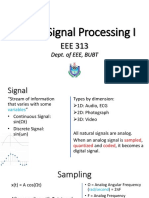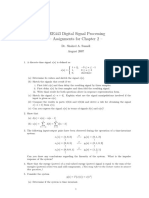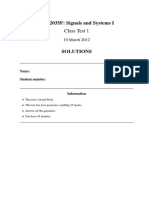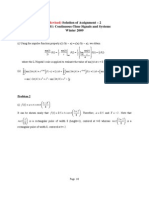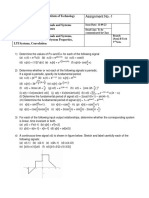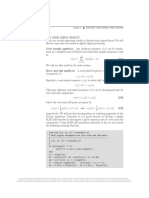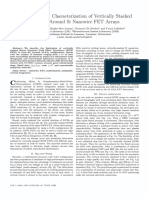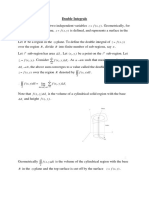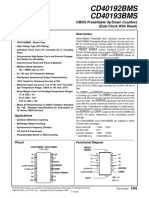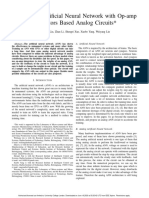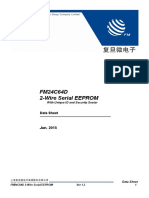Tutorial I EKT 230 Signals & Systems
1. Sketch the waveforms of the following signals:
(i) x(t) = u(t+1) - 2u(t) + u(t-1)
ans:
(ii)x(t) = -u(t+3) + 2u(t+1) – 2u(t-1) + u(t-3)
ans:
(iii) x(t) = r(t+2) – r(t+1) -r(t-1)+r(t-2)
ans:
Tutorial I
� Tutorial I EKT 230 Signals & Systems
2. Let x[n] and y[n] be given in Figure 1(a) and 1(b), respectively.
Carefully sketch the
following signals:
Figure 1(a) and (b)
(i) x[3n-1]
ans:
(ii) y[2-2n]
ans:
Tutorial I
� Tutorial I EKT 230 Signals & Systems
(iii) x[n-2] + y[n+2]
ans:
(iv) x[2n]+y[n-4]
ans:
(v) x[n+2]y[n-2]
ans:
Tutorial I
� Tutorial I EKT 230 Signals & Systems
(vi) x[n]y[-2-n]
ans:
3. Let x(t) and y(t) be given in Figs. 2(a) and (b), respectively.
Carefully sketch the following signals:
(a) x(t-1)y(-t)
(b) x(t)y(-1-t)
(c) x(2t)y(t/2+1)
(d) x(4-t)y(t)
Tutorial I
� Tutorial I EKT 230 Signals & Systems
Answer:
(a) x(t-1)y(-t)
Tutorial I
� Tutorial I EKT 230 Signals & Systems
(b) x(t)y(-1-t)
(c) x(2t)y(t/2+1)
(d) x(4-t)y(t)
Tutorial I
� Tutorial I EKT 230 Signals & Systems
4. A discrete-time signal;
1, 0 n 8
x[n]
0, otherwise
Using u[n], describe x[n] as the superposition of two step
functions.
Answer:
x[ n] u[ n] u[ n 10]
5. Given the signal x[n] (n 6) u[n] u[n 6] , sketch and
label the waveform for each of the following signals:
(i) x[ n 2]
(ii) x[3 n]
Tutorial I
� Tutorial I EKT 230 Signals & Systems
Answer:
Signal x[n] (n 6) u[n] u[n 6] can be described as
below:
(i) x[ n 2] time shifting to right side by
2
Tutorial I
� Tutorial I EKT 230 Signals & Systems
(ii) x[3n 3] time shifting to right side by 3,
continued by time scaling with scale of 3.
(iii) x[3 n] x[ n 3] time shifting to left side by 3, then
reflect with respect to origin.
Tutorial I
� Tutorial I EKT 230 Signals & Systems
6. Determine whether the system y[n] = nx[n-1]+2 is :
(i) memoryless
No. y[n] depends on x[n-1].
(ii) time invariant
No.
x[n] y[n] and y[n-no] = (n- no)x[n- no-1]+2
x1 = x[n- no] y[n] = nx1[n-1]+2 = nx[n- no-1]+2
y[n] ≠ y[n-no]
(iii) linear
No.
x1 y1[n] = nx1[n-1]+2
x2 y2[n] = nx2[n-1]+2
x3 = x1 + x2 y3[n] = nx3[n-1]+2 = nx1[n-1] + nx2[n-1]+2
≠ y1[n]+y2[n]
(iv) causal
Tutorial I
� Tutorial I EKT 230 Signals & Systems
Yes.
y[n] depends on x[n-1]. (Past)
(v) stable
No.
Let | x[n] | A | y[n] || nx[n 1] 2 |
nx[n 1] 2 nA 2 unbounded
Take x[n] 1n | x[n] | 1 also
|y[n]| = n+2 n+2 ∞ as n ∞ unbounded
7. Consider a continuous-time system with input x(t) and output y(t) related by
y (t ) x (sin(t ))
(a) Is the system causal ?
Ans :
The system is not causal because the output y(t) at some time may depend on
future values of x(t). For instance y(-π) = x(0)
(b) Is the system linear ?
Ans :
Consider two arbitrary inputs x1(t) and x2(t).
x1 y1(t) = x1(sin(t))
x2 y2(t) = x2(sin(t))
Let x3(t) be a linear combination of x1(t) and x2(t). That is,
x3(t) = ax1(t) + bx2(t)
where a and b are arbitrary scalars. If x3(t) is the input to the given system,
then corresponding output y3(t) is
y3(t) = x3(sin(t))
Tutorial I
� Tutorial I EKT 230 Signals & Systems
= ax1(sin(t)) + bx2(sin(t))
= ay1(t) + by2(t)
Hence, the system is linear.
8. Determine whether the corresponding system is linear, time invariant or both.
(a) y[n] = x2[n-2]
Ans:
(i) linearity
x1 y1[n] = x12[n-2]
x2 y2[n] = x22[n-2]
Let x3(t) be a linear combination of x1[n] and x2[n]. That is:
x3(t) = ax1[n] + bx2[n]
where a and b are arbitrary scalars. If x 3(t) is the input to
the given system, then
the corresponding output y3(t) is
2
y3[n] = x3 [ n 2]
= (ax1 [n 2] bx2 [n 2]) 2
2 2
= a 2 x1 [ n 2] b 2 x 2 [n 2] 2abx1 [n 2]x 2 [n 2]
≠ ay1[n] + by2[n]
The system is not linear
(ii) time invariant
Consider an arbitrary input x1[n]. Let
y1[n] = x1 2 [n 2]
be the corresponding output. Consider a second input
x2[n] obtained by shifting
x1[n] in time:
x2[n] = x1 [n no ]
The output corresponding to this input is
2 2
y 2 [n] x 2 [n 2] x1 [n 2 no ]
Tutorial I
� Tutorial I EKT 230 Signals & Systems
Also note that
2
y1 [n no ] x1 [ n 2 no ]
Therefore
y 2 [n] y1 [n no ]
The system is time-invariant.
(b) y[n] = Od{x(t)}
i) linearity
Consider two arbitrary inputs x1(t) and x2(t).
x1 y1(t) = Od{x1(t)}
x2 y2(t) = Od{x2(t)}
Let x3(t) be a linear combination of x1(t) and x2(t). That is,
x3(t) = ax1(t) + bx2(t)
where a and b are arbitrary scalars. If x3(t) is the input to the given system,
then the corresponding output y3(t) is
y3(t) = Od{x3(t)}
= Od{ax1(t) + bx2(t)}
= aOd{x1(t)} + bOd{x2(t)} = ay1(t) + by2(t)
Hence, the system is linear
ii) time invariance
Consider an arbitrary input x1[n]. Let
x1 (t ) x1 (t )
y1(t) = Od{x1 (t )}
2
be the corresponding output. Consider a second input
x2[n] obtained by
shifting x1[n] in time:
x2(t) = x1 (t t o )
The output corresponding to this input is
x (t ) x 2 (t )
y 2 (t ) Od {x 2 (t )} 2
2
Tutorial I
� Tutorial I EKT 230 Signals & Systems
x1 (t t o ) x1 (t t o )
2
Also note that
x1 (t t o ) x1 (t t o )
y1 (t t o ) y 2 (t )
2
Therefore, the system is not time-invariant.
Tutorial I

